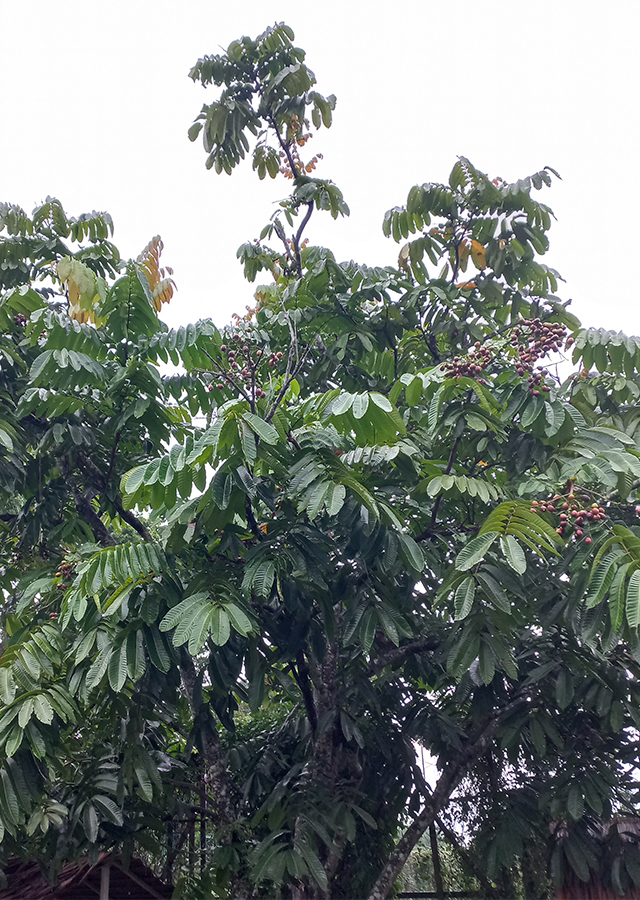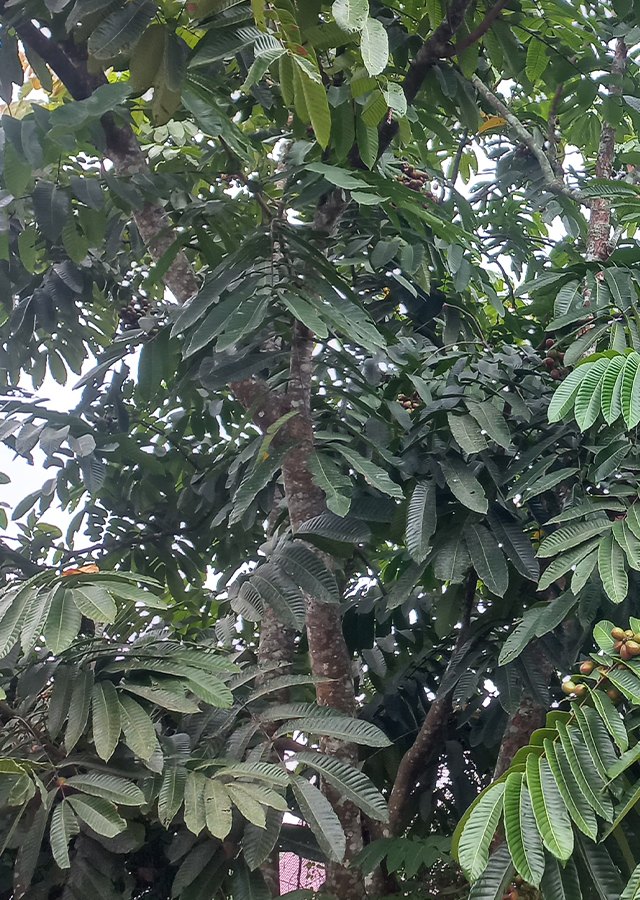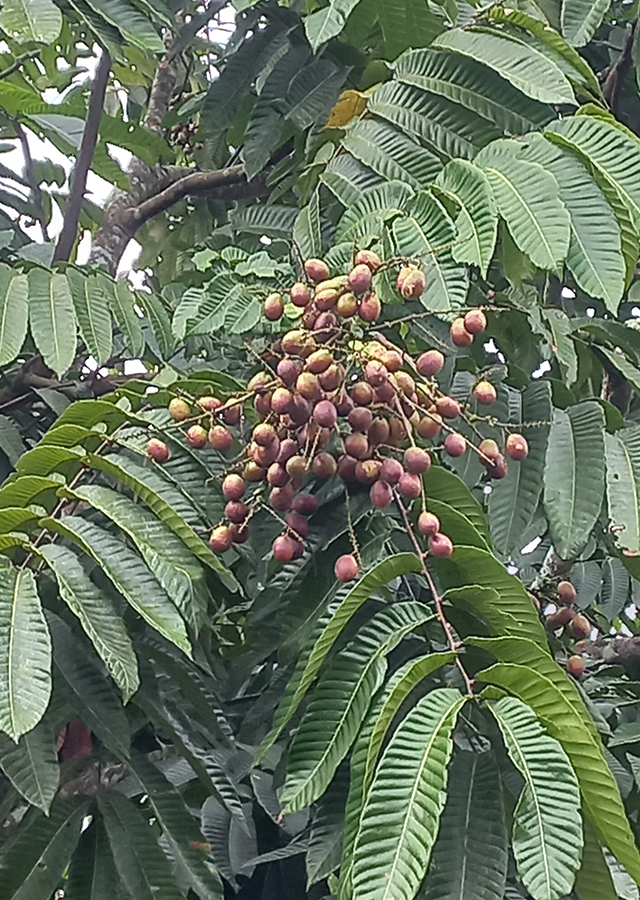Traditional Herbs from Pometia pinnata
fever
- Take enough fresh matoa leaves, wash them thoroughly.
- Boil until boiling.
- Let it warm/cool.
- Strain and drink.
treat_wounds
- Take the skin wash enough matoa stems until clean.
- Crush until it becomes a paste.
- Apply on the wound.
What is Pometia pinnata Looks like??



Parts of Pometia pinnata that could be used
- Leaves
- Bark
- Latex
Pometia pinnata Distribution
Matoa or Pometia pinnata is a plant native to Papua. Pometia pinnata is better known as a type of commercial wood-producing tree that is often found in Papua, although in fact this type of tree has long been known as a very popular local fruit producer, known as matoa fruit. Matoa fruit has a very specific taste. Most people say it has a combination of rambutan and longan flavors. Because of its unique taste, traditionally this fruit is much sought after and marketed in local markets in Papua. The largest production of matoa fruit comes from Jayapura although in other areas such as Yapen Waropen, Nabire and Manokwari you can also find matoa fruit in traditional markets. Recently, matoa fruit has even spread and is known nationally as an economically promising fruit. Matoa is often used in traditional medicine in the Pacific Islands. Matoa has also been studied to have antimicrobial, antibacterial and antioxidant activity.Agroecology of Pometia pinnata
Matoa is a plant in the humid tropical lowlands, usually found at altitudes below 500 m above sea level, although sometimes found at altitudes of 1,700 m above sea level. In its native range, matoa does well with average annual rainfall in the range of 1,500 � 5,000 mm, without severe dry seasons. The average annual temperature ranges between 22 - 28 °C, the average maximum temperature is 25 - 32 °C and the minimum tolerance is 5 - 16 °C. Prefers deep, fertile, moist soil and a position in full sun or light shade. This tree is found in a variety of soils in its native range: on limestone, clay, sandy or loamy soils, mostly in dryland forests, sometimes in freshwater swamps. The tree grows very fast with a height increase of 1.7 m recorded in one year.
Morphology of Pometia pinnata
- Roots have a taproot system.
- The stem can reach >100 cm in diameter, has buttresses (board roots) with a height of up to 5 m, has straight trunks but sometimes there are also crooked trunks with many branches, round and tall crowns free of first branches 18 \u2013 30 m. Dead outer skin 0.2 -2 mm thick, light gray to red brown, skin with shallow grooves and peeling into small pieces.
- Compound leaves are alternate, stemmed, which are more than 1 m long. Each leaf consists of 4\u201315 pairs of leaflets, and has no terminal leaflets. Thin to leathery egg-shaped to drop-shaped, few to clear sickle-shaped, red when young, dark green above and light green below when mature, hairless to covered with hair, 6\u201340 times 2\u201313 cm, and with toothed margins. The lowest pair of leaflets is smaller than the others, rounded, ear-shaped or cushion-shaped, 0.4\u20133 by 0.3\u20135 cm, looking like stipules, and with one of the leaflets reduced. .\\
- Flowers of monoecious plants, producing male and female flowers on the same individual. The flowers are about 2\u20132.5 mm, generally white to green-yellow in color, and appear on branching flower stalks that are 15\u201370 cm long.
- Flesh\u00a0fruits have individual stony cores, ellipsoid to round, 1, 5\u20135 by 1-3 cm, and red to black when ripe.
- Egg-shaped seeds, unequal sides, up to 2.5 times 1.5 cm, brown in color, and with a white cover (aril).
Cultivation of Pometia pinnata
Matoa is very easy to grow through seeds, but the problem is that matoa seeds cannot be stored in the long term (recalcitrant), making it difficult to provide seeds. Matoa seeds that have just been taken from the tree if planted immediately will germinate well, but if stored for one week germination has dropped very drastically.
Pometia pinnata, more details :
Chemical Content of Pometia pinnataAlkaloids, saponins, tannins, triterpenoids, flavonoids, phenolic compounds.
Benefits of Pometia pinnata
Used to treat bone aches, migraine headaches, help expel the placenta after giving birth, relieve aches and pains in muscles and joints, relieve fever, cure flu and colds, cure diarrhea, stomach ache, coughs, constipation, diaper rash, wounds, treat uncovered fontanel, vomiting medicine for mouth infections, colds and mucus congestion, to treat stomach ache, treat mouth cancer. Has antimicrobial, antibacterial and antioxidant activity.
Simplisia of Pometia pinnata
- Take enough fresh matoa leaves, wash them with running water until clean.
- Dry at a temperature of 30-60\u00a0\u00b0C.
- Choose using a blender until they become powder.
- Store in a clean, airtight container." ]
Another Facts for Pometia pinnata :
Synonym of Pometia pinnata
Aporetica pinnata (J.R.Forst. & G.Forst.) DC., Dabanus pinnatus (J.R.Forst. & G.Forst.) Kuntze, Euphoria pinnata (J.R.Forst. & G.Forst.) Poir.
Habitus of Pometia pinnata
Tree. Annual tree reaching 40 m or more in height
Habitat of Pometia pinnata
- Riverside", "Forest", "Land
No comments:
Post a Comment